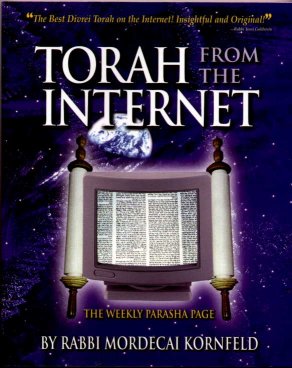
More Parasha-Pages |
Weekly Parasha-Page |
 Ask a Question |
|
This week's publication has been sponsored by Alan, Sophia and their son Jared Ziegler to honor the memory of Alan's grandmother, Faige bat Shlomo Zalman (Fanny) Feibus (Yahrzeit: Adar 24).
PARASHAT VAYIKRA 5758THE SACRIFICIAL SERVICEAlthough this practice may seem bizarre to the uninitiated, the early commentaries point out the profound and enduring effect that offering a sacrifice has on a sinner. Man, like animal, is a physical organism of flesh and blood. Both are driven by their lusts and emotions; all that separates man from animal is his intellect. When a person sins because he allows his desires to get the better of his intellect, he puts himself on equal footing with the animal. It is necessary to impress upon such a person the futility of physical existence which is not led by the mind's rational judgment. This is accomplished by having him offer a sacrifice. The sinner brings a body of flesh and blood, like his own, to the Mikdash. There, he slaughters it and burns it on the altar -- much as he allowed his own body to be "burned" by the fire of desire (Rabeinu Bachye 1:9). The blood is sprinkled on the altar and the intestines and fats (the vehicles of desire) are burned, to demonstrate "there, but for the grace of G-d, go I" (Ramban 1:9). It is thus vividly portrayed to him that a body without a mind is valueless (Chinuch, Mitzvah #95). The meat of the sacrifice provides sustenance for the Kohanim, educators of the people and purveyors of the Torah (Devarim 33:10), who then pray for the complete atonement of the sinner (Ramban). This is one approach to the sacrificial service. Other approaches, ranging from the philosophical to the mystical, have been proposed as well, each shedding light on yet another aspect of the Temple service. Particularly intriguing is that of the Rambam. IIRamban (1:8), however, finds this approach absolutely unacceptable. It is unthinkable to assume that the purpose of sacrifices is no more than to demonstrate the absurdity of the foolish practices of idolaters! Besides, we find that before any idolaters began serving animals, animal sacrifices were offered by Adam (Shabbat 28b), his sons (Bereishit 4:4) and Noach (Bereishit 8:20). How can the Rambam state that sacrifices only became necessary after people began to deify animals? Perhaps the answer to these questions lies in a better understanding of what prompted people to deify animals in the first place. Rabeinu Bachye (1:9) explains that the Egytians realized the great benefit that one derives from the wool, offspring and milk of sheep. In the words of Chazal (Rashi Devarim 7:13), "Why are [sheep] called 'Ashterot' (ibid.)? Because the make their owners rich (Me'ashrot)!" The same applies to goats, and to cows -- which provide not only milk and offspring but plow the fields as well, thus producing a large proportion of the daily rations. The nations deified these animals in an attempt to appeal to the powers of sustenance that they perceived in them. (This is not dissimilar from the manner in which people today often put considerable amounts of time and effort into a particular non-Torah mode of behavior, convinced that it will bring them "true happiness and peace of mind.") We, who know that Hashem provides us with our livelihood and no other, do not attribute any supernatural powers to such animals. They are simply the vehicles through which the Omnipotent One provides us with our daily needs, and have no power unto themselves. Even in the absence of actual idol-worship, the sacrificial service is necessary as a declaration that we "know the hand that is feeding us." By offering these animals on the altar in Hashem's service, we are declaring that He is the G-d of G-ds and all that we have is from Him alone. As such, the sacrificial service relates to more than just the folly of misguided nations; it denotes that we realize Who has granted us all that we have. It was certainly appropriate even for Adam and Noach to offer animal sacrifices. IIIHaga'on Rav Yehoshua Leib Diskin used this theme to explain a Gemara in Yoma (42a). The Gemara tells us that a red ribbon of two Sela-weights was tied to the scapegoat on Yom Kippur, and when the Jews achieved a full atonement through the scapegoat it turned white. Perhaps, Rav Diskin explains, this was because the scapegoat, like the other goats offered on the holidays, was meant to atone for the sin of selling Yosef. According to the Gemara (Shabbos 10b), the cloak given Yosef by his father which aroused the brothers' jealousy for Yosef (Bereishit 37:3) weighed exactly two Sela-weights more than those of his brothers. The two Sela-weight red ribbon turned white to demonstrate that Hashem would forgive the nation for persecuting Yosef because of his two Sela-weight cloak! | ||
